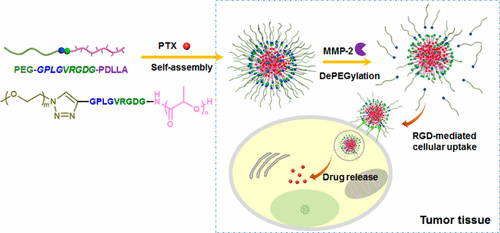当前位置:
X-MOL 学术
›
Bioconjugate Chem.
›
论文详情
Our official English website, www.x-mol.net, welcomes your
feedback! (Note: you will need to create a separate account there.)
Matrix Metalloproteinase-Responsive Multifunctional Peptide-Linked Amphiphilic Block Copolymers for Intelligent Systemic Anticancer Drug Delivery
Bioconjugate Chemistry ( IF 4.0 ) Pub Date : 2017-07-13 00:00:00 , DOI: 10.1021/acs.bioconjchem.7b00330 Wendong Ke 1 , Zengshi Zha 1 , Jean Felix Mukerabigwi 1 , Weijian Chen 1 , Yuheng Wang 1 , Chuanxin He 2 , Zhishen Ge 1
Bioconjugate Chemistry ( IF 4.0 ) Pub Date : 2017-07-13 00:00:00 , DOI: 10.1021/acs.bioconjchem.7b00330 Wendong Ke 1 , Zengshi Zha 1 , Jean Felix Mukerabigwi 1 , Weijian Chen 1 , Yuheng Wang 1 , Chuanxin He 2 , Zhishen Ge 1
Affiliation

|
The amphiphilic block copolymer anticancer drug nanocarriers clinically used or in the progress of clinical trials frequently suffer from modest final therapeutic efficacy due to a lack of intelligent features. For example, the biodegradable amphiphilic block copolymer, poly(ethylene glycol)-b-poly(d,l-lactide) (PEG–PDLLA) has been approved for clinical applications as a paclitaxel (PTX) nanocarrier (Genexol–PM) due to the optimized pharmacokinetics and biodistribution; however, a lack of intelligent features limits the intracellular delivery in tumor tissue. To endow the mediocre polymer with smart properties via a safe and facile method, we introduced a matrix metalloproteinase (MMP)-responsive peptide GPLGVRGDG into the block copolymer via efficient click chemistry and ring-opening polymerization to prepare PEG–GPLGVRGDG–PDLLA (P1). P1 was further self-assembled into micellar nanoparticles (NPs) to load PTX, which show MMP-2-triggered dePEGylation due to cleavage of the peptide linkage. Moreover, the residual VRGDG sequences are retained on the surface of the NPs after dePEGylation, which can serve as ligands to facilitate the cellular uptake. The cytotoxicity of PTX loaded in P1 NPs against 4T1 cells is significantly enhanced as compared with free PTX or PTX-loaded PEG–GPLGVRG–PDLLA (P2) and PEG–PDLLA (P3) NPs. In vivo studies confirmed that PTX-loaded P1 NPs show prolonged blood circulation, which are similar to P2 and P3 NPs but exhibit more-efficient accumulation in the tumor site. Ultimately, PTX-loaded P1 NPs display statistically significant improvement of antitumor activity against tumor-bearing mice via systemic administration. Therefore, the strategy by facile incorporation of a responsive peptide linkage between PEG and PDLLA is a promising approach to improving the therapeutic efficacy of anticancer-drug-loaded amphiphilic block copolymer micelles.
中文翻译:

基质金属蛋白酶响应的多功能肽连接的两亲嵌段共聚物,用于智能系统的抗癌药物递送。
由于缺乏智能特征,临床上使用的两亲嵌段共聚物抗癌药物纳米载体或在临床试验的进展中经常遭受适度的最终治疗功效。例如,可生物降解的两亲嵌段共聚物,聚(乙二醇)-b-聚(d,l-丙交酯(PEG-PDLLA)由于优化了药代动力学和生物分布,已被批准用于紫杉醇(PTX)纳米载体(Genexol-PM),用于临床。然而,缺乏智能特征限制了肿瘤组织中的细胞内递送。为了通过安全,简便的方法使中等性能的聚合物具有智能特性,我们通过高效的点击化学和开环聚合反应将基质金属蛋白酶(MMP)响应肽GPLGVRGDG引入嵌段共聚物中,以制备PEG– GPLGVRGDG –PDLLA(P1) 。P1进一步自组装成胶束纳米颗粒(NPs)以装载PTX,其显示由于肽键的断裂而触发了MMP-2触发的dePEG化。而且,残留的VRGDG序列在去聚乙二醇化后保留在NP的表面上,可以用作促进细胞摄取的配体。与游离PTX或负载PTX的PEG– GPLGVRG –PDLLA(P2)和PEG–PDLLA(P3)NPs相比,P1 NP中负载的PTX对4T1细胞的细胞毒性显着增强。体内研究证实,载有PTX的P1 NP显示血液循环延长,类似于P2和P3NP但是在肿瘤部位表现出更有效的积累。最终,通过全身给药,载有PTX的P1 NP在统计学上显着提高了对荷瘤小鼠的抗肿瘤活性。因此,通过在PEG和PDLLA之间容易地掺入反应性肽键的策略是一种有前途的方法,可以改善载有抗癌药的两亲嵌段共聚物胶束的治疗效果。
更新日期:2017-07-14
中文翻译:

基质金属蛋白酶响应的多功能肽连接的两亲嵌段共聚物,用于智能系统的抗癌药物递送。
由于缺乏智能特征,临床上使用的两亲嵌段共聚物抗癌药物纳米载体或在临床试验的进展中经常遭受适度的最终治疗功效。例如,可生物降解的两亲嵌段共聚物,聚(乙二醇)-b-聚(d,l-丙交酯(PEG-PDLLA)由于优化了药代动力学和生物分布,已被批准用于紫杉醇(PTX)纳米载体(Genexol-PM),用于临床。然而,缺乏智能特征限制了肿瘤组织中的细胞内递送。为了通过安全,简便的方法使中等性能的聚合物具有智能特性,我们通过高效的点击化学和开环聚合反应将基质金属蛋白酶(MMP)响应肽GPLGVRGDG引入嵌段共聚物中,以制备PEG– GPLGVRGDG –PDLLA(P1) 。P1进一步自组装成胶束纳米颗粒(NPs)以装载PTX,其显示由于肽键的断裂而触发了MMP-2触发的dePEG化。而且,残留的VRGDG序列在去聚乙二醇化后保留在NP的表面上,可以用作促进细胞摄取的配体。与游离PTX或负载PTX的PEG– GPLGVRG –PDLLA(P2)和PEG–PDLLA(P3)NPs相比,P1 NP中负载的PTX对4T1细胞的细胞毒性显着增强。体内研究证实,载有PTX的P1 NP显示血液循环延长,类似于P2和P3NP但是在肿瘤部位表现出更有效的积累。最终,通过全身给药,载有PTX的P1 NP在统计学上显着提高了对荷瘤小鼠的抗肿瘤活性。因此,通过在PEG和PDLLA之间容易地掺入反应性肽键的策略是一种有前途的方法,可以改善载有抗癌药的两亲嵌段共聚物胶束的治疗效果。











































 京公网安备 11010802027423号
京公网安备 11010802027423号